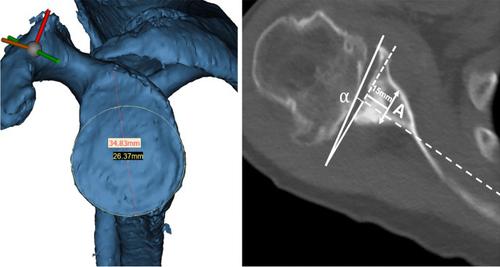International Orthopaedics ( IF 2.0 ) Pub Date : 2023-02-10 , DOI: 10.1007/s00264-023-05706-z Colin Shing-Yat Yung 1 , Christian Fang 1 , Evan Fang 1 , Yuk-Chuen Siu 2 , Dennis King Hang Yee 3 , Kevin Kwun-Hung Wong 4 , Kai-Chung Poon 5 , Matthew Man Fai Leung 1 , Jonathan Wan 5 , Tak-Wing Lau 1 , Frankie Leung 1

|
Purpose
Glenoid component loosening is a potential complication of reverse total shoulder arthroplasty (rTSA), occurring in part due to lack of adequate screw purchase in quality scapular bone stock. This study was to determine the efficacy of a surgeon-designed, 3D-printed patient-specific instrumentation (PSI) compared to conventional instrumentation (CI) in achieving longer superior and inferior screw lengths for glenoid component fixation.
Methods
A multi-centre retrospective analysis of patients who underwent rTSA between 2015 and 2020. Lengths of the superior and inferior locking screws inserted for fixation of the glenoid baseplate component were recorded and compared according to whether patients received PSI or CI. Secondary outcomes included operative duration and incidence of complications requiring revision surgery.
Results
Seventy-three patients (31 PSI vs. 42 CI) were analysed. Average glenoid diameter was 24.5 mm (SD: 3.1) and 81% of patients had smaller glenoid dimensions compared to the baseplate itself. PSI produced significantly longer superior (44.7 vs. 30.7 mm; P < 0.001) and inferior (43.0 vs. 31 mm; P < 0.001) mean screw lengths, as compared to CI. A greater proportion of maximal screw lengths for the given rTSA construct (48 mm) were observed in the PSI group (71.9% vs. 11.9% superior, 59.4% vs. 11.9% inferior). Operative duration was not statistically significantly different between the PSI and CI groups (150 min vs. 169 min, respectively; P = 0.229). No patients had radiographic loosening of the glenoid component with an average of 2-year follow-up.
Conclusion
PSI facilitates longer superior and inferior screw placement in the fixation of the glenoid component for rTSA. With sufficient training, PSI can be designed and implemented by surgeons themselves.
中文翻译:

外科医生设计的患者专用器械改善了关节盂尺寸较小人群反向全肩关节置换术的关节盂组件螺钉放置
目的
关节盂组件松动是反向全肩关节置换术 (rTSA) 的潜在并发症,发生的部分原因是在优质肩胛骨存量中没有购买足够的螺钉。本研究旨在确定外科医生设计的 3D 打印患者专用器械 (PSI) 与传统器械 (CI) 相比在实现更长的上、下螺钉长度以固定关节盂组件方面的效果。
方法
对 2015 年至 2020 年间接受 rTSA 的患者进行多中心回顾性分析。根据患者是否接受 PSI 或 CI,记录并比较为固定关节盂底板组件而插入的上下锁定螺钉的长度。次要结果包括手术持续时间和需要翻修手术的并发症发生率。
结果
分析了 73 名患者(31 PSI 与 42 CI)。关节盂的平均直径为 24.5 mm (SD: 3.1),81% 的患者关节盂尺寸小于底板本身。 与 CI 相比, PSI 产生的上级(44.7 与 30.7 毫米; P < 0.001)和下级(43.0 与 31 毫米;P < 0.001)平均螺钉长度明显更长。在 PSI 组(71.9% 对 11.9%,59.4% 对 11.9%,优于 71.9% 对 11.9%,59.4% 对 11.9%)观察到给定 rTSA 结构(48 毫米)的最大螺钉长度比例更大。PSI 和 CI 组的手术持续时间在统计学上没有显着差异(分别为 150 分钟和 169 分钟;P = 0.229)。在平均 2 年的随访中,没有患者出现关节盂组件的影像学松动。
结论
PSI 有助于在 rTSA 的关节盂组件固定中放置更长的上下螺钉。通过足够的培训,PSI 可以由外科医生自己设计和实施。
















































 京公网安备 11010802027423号
京公网安备 11010802027423号